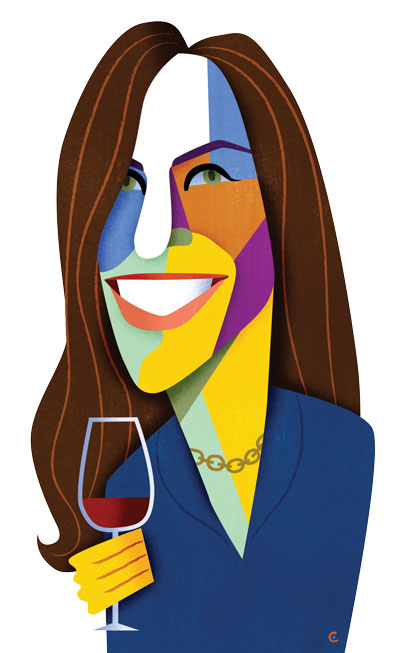Doctor and Vintner
Doctor and Vintner
For Kerith Overstreet ’98M (MD), the path from pathologist to winemaker was a smooth one.
I majored in English at Cornell. Rochester was my top choice for medical school because it had the reputation of having an artsy, diverse student population. I think that’s probably from having the bio-psycho-social model in place before that became de rigueur at every medical school. In my medical school class, we had an opera singer and multiple writing majors from Johns Hopkins.
I ended up in surgical pathology. I taught a lot of medical students and residents and published about 12 papers. And all that time I really liked wine. In 2008 I had the opportunity to make wine on a really small scale, at an urban winery in San Francisco called Crushpad. I jumped in, and I fell in love with it.

Illustration: David Cowles for Rochester Review
“Wine is part of a total experience. Nobody comes back from their honeymoon or vacation waxing poetic about the vodka.”
They come back and tell you about the wine. Not a week goes by when I don’t get an email from somebody saying, “our granddaughter was born, and we opened a bottle of your wine”—and they send a picture. Or, “we went on this hiking trip, and your wine was the one bottle we carried in our backpack”—and there’s a picture. That’s really special to me.
Wine is also a wonderful mix of science and artistry. I often give talks about harvest chemistry and the parameters that we measure, which are both quantitative and qualitative. I can look at the sugar levels and measure that with a number. I look at the acid levels and quantify it. But on the other hand, you have to walk the vineyard yourself. You have to taste the grapes; look at the clusters and the seeds; chew the seeds and taste them, to assess the quality and maturity of the tannins. You inspect and taste the skins. You taste the pulp and then you spit it out to see if it is separating cleanly from the seeds. I measure, look for, and taste for indicators of harvest maturity.
Monitoring fermentation is a lot like doing rounds with patients. Every morning during harvest, the first thing I do is check on all my tanks. First, I look at the temperature. What was the temperature overnight? Was there a spike? I certainly hope not, because I set a cooling jacket. Then I look at what the Brix [a proxy for sugar content] did overnight. I also see what the cap is doing. Does it still seem firm? Has it fallen down? And of course, I smell the tanks, the juice. Once you assess the tanks, you decide what you’re going to do for the day—a lot like internal medicine. It’s sort of funny that way. In the afternoon, you do the same thing all over again. You make rounds twice a day.
Artisanal winemaking is all about the vineyard. Mass-produced wines come from a broad area and are made in a large production facility. They don’t speak specifically to a site. The fruit that I work with and the growing partners that I have are designed to make a wine that speaks to a particular place. Wines from this vineyard taste like they do because the climate is a certain way, the fog and wind are a certain way, because the bushes that surround the vines are endemic to that place.
I drained and pressed my last tank in early October. It’s always a bittersweet time. Harvest is my favorite time of year, and after that, 99 percent is in the rear-view mirror. No more fruit to sort. Just waiting for my chardonnay to do its thing, ferment in the barrel.
Just weeks after harvest, the Kincade fire burned over 75,000 acres. Fortunately for Bruliam, my wines already were safe in barrel. Actually, 93 percent of Sonoma County was picked before the fire erupted. Nonetheless, lives and businesses were disrupted; homes were destroyed. I hope the national news coverage reminds people to support Sonoma County.
Kerith Overstreet ’98M (MD)
Healdsburg, California
Winemaker & Proprietor, Bruliam Wines
On “playing” with wine: “Coming from the academic side of medicine, I love doing ‘trials’ in the winery. I’ll pull 750 mls out of a barrel and play with it and see what it does. To me that’s the fun part. Messing around in the winery.”
On the necessity of patience: “Our neurology professor, Dr. [Ralph] Józefowicz, used to help us practice patience by saying, “Don’t just do something. Stand there.” That’s the hardest part of winemaking—after the harvest, just standing there.”
— Karen McCally ’02 (PhD)
This article originally appeared in the fall 2019 issue of Rochester Review magazine.


